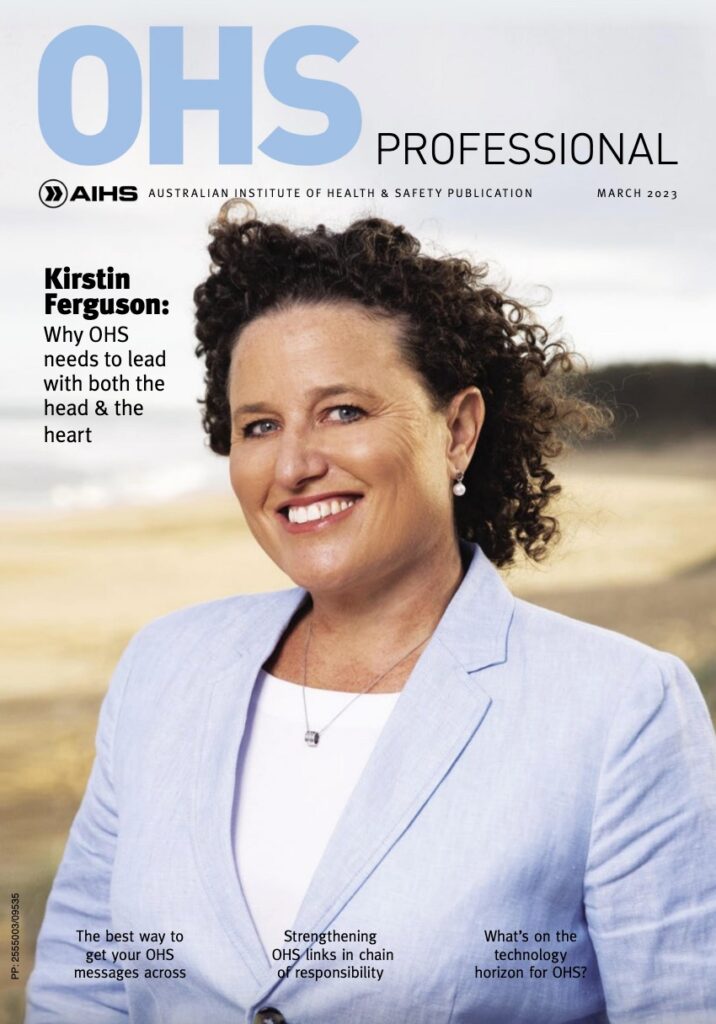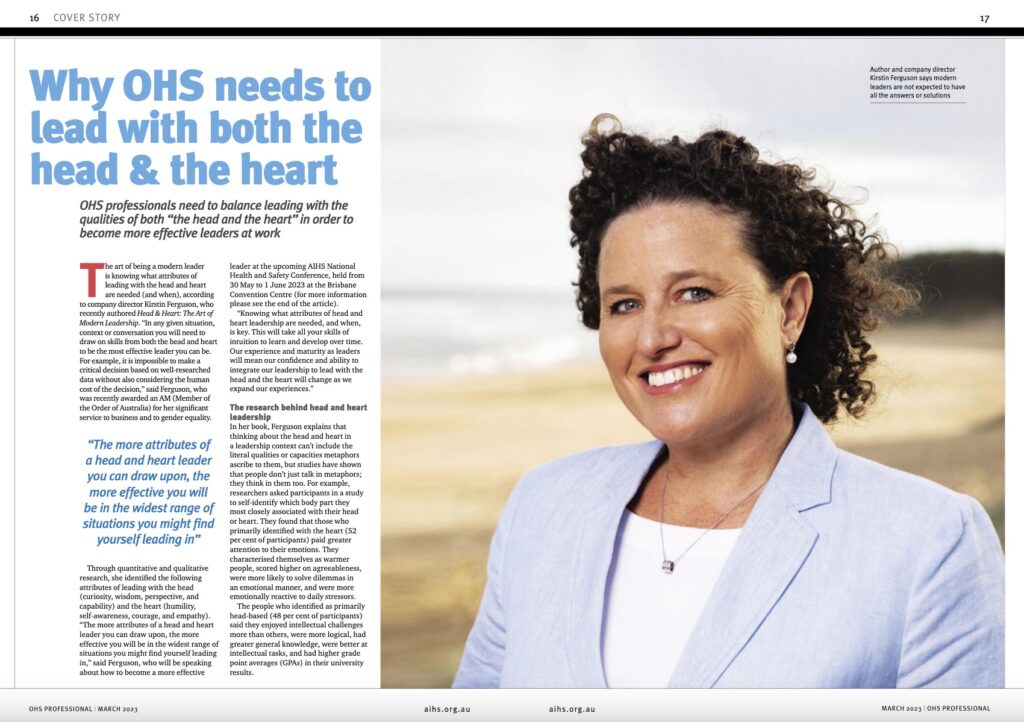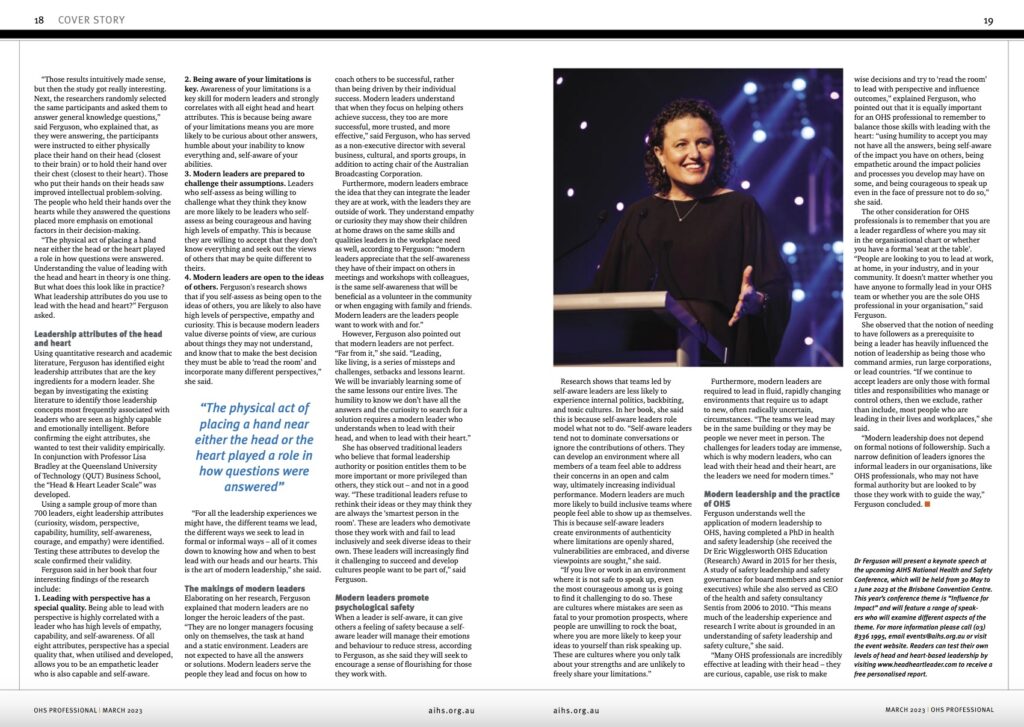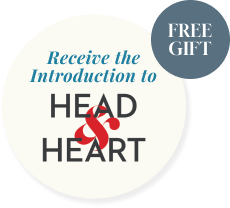
Complete the Head & Heart Leader Scale™ and receive a free, personalised report here.
Complete the Head & Heart Leader Scale™ and receive a free, personalised report here.

OHS professionals need to balance leading with the qualities of both “the head and the heart” in order to become more effective leaders at work
The art of being a modern leader is knowing what attributes of leading with the head and heart are needed (and when), according to company director Kirstin Ferguson, who recently authored Head & Heart: The Art of Modern Leadership. “In any given situation, context or conversation you will need to draw on skills from both the head and heart to be the most effective leader you can be. For example, it is impossible to make a critical decision based on well-researched data without also considering the human cost of the decision,” said Ferguson, who recently awarded an AM (Member of the Order of Australia) for her significant service to business and to gender equality.
Through quantitative and qualitative research, she identified the following attributes of leading with the head (curiosity, wisdom, perspective and capability) and the heart (humility, self-awareness, courage and empathy). “The more attributes of a head and heart leader you can draw upon, the more effective you will be in the widest range of situations you might find yourself leading in,” said Ferguson, who will be speaking about how to become a more effective leader at the upcoming AIHS National Health and Safety Conference, which will be held from 30 May to 1 June 2023 at the Brisbane Convention Centre (for more information please see the end of the article).
“Knowing what attributes of head and heart leadership are needed, and when, is key. This will take all your skills of intuition to learn and develop over time. Our experience and maturity as leaders will mean our confidence and ability to integrate our leadership to lead with the head and the heart will change as we expand our experiences.”
The research behind head and heart leadership
In her book, Ferguson explains that thinking about the head and heart in a leadership context can’t include the literal qualities or capacities metaphors ascribe them, but studies have shown that people don’t just talk in metaphors but think in them too. For example, researchers asked participants in a study to self-identify which body part they most closely associated with their head or their heart. They found that those who primarily identified with the heart (52 per cent of participants) paid greater attention to their emotions. They characterised themselves as warmer people, they scored higher on agreeableness, said they were more likely to solve dilemmas in an emotional manner, and they were more emotionally reactive to daily stressors.
The people who identified as primarily head-based (48 per cent of participants) said they enjoyed intellectual challenges more than others, were more logical, had greater general knowledge, were better at intellectual tasks, and had higher grade point averages (GPAs) in their university results.
“Those results intuitively made sense, but then the study got really interesting. Next, the researchers randomly selected the same participants and asked them to answer general knowledge questions,” said Ferguson, who explained that, as they were answering, the participants were instructed to either physically place their hand on their head (closest to their brain) or to hold their hand over their chest (closest to their heart). Those who put their hands on their heads saw improved intellectual problem solving. The people who held their hands over the hearts while they answered the questions placed more emphasis on emotional factors in their decision-making.
“The physical act of placing a hand near either the head or the heart played a role in how questions were answered. Understanding the value of leading with the head and heart in theory is one thing. But what does this look like in practice? What leadership attributes do you use to lead with the head and heart?” Ferguson asked.
Leadership attributes of the head and heart
Using quantitative research and academic literature, Ferguson has identified eight leadership attributes that are the key ingredients for a modern leader. She began by investigating the existing literature to identify those leadership concepts most frequently associated with leaders who are seen as highly capable and emotionally intelligent. Before confirming the eight attributes, she wanted to empirically test their validity. In conjunction with Professor Lisa Bradley at the Queensland University of Technology (QUT) Business School, the “Head & Heart Leader Scale” was developed.
Using a sample group of more than 700 leaders, eight leadership attributes (curiosity, wisdom, perspective and capability, and humility, self-awareness, courage and empathy) were identified, and testing these attributes to develop the scale was able to confirm their validity.
Ferguson said in her book that four interesting findings of the research include:
1. Leading with perspective has a special quality. Being able to lead with perspective is highly correlated with a leader who has high levels of empathy, capability and self-awareness. Of all eight attributes, perspective has a special quality that, when utilised and developed, allows you to be an empathetic leader who is also capable and self-aware.
2. Being aware of your limitations is key. Being aware of your limitations is a key skill for modern leaders and strongly correlates with all eight head and heart attributes. This is because being aware of your limitations means you are more likely to be curious about other answers, humble about your inability to know everything and self-aware of your abilities.
3. Modern leaders are prepared to challenge their assumptions. Leaders who self-assess as being willing to challenge what they thought they knew are more likely to be leaders who self-assess as being courageous and having high levels of empathy. This is because they are willing to accept they don’t know everything and are willing to seek out the views of others that may be quite different to theirs.
4. Modern leaders are open to the ideas of others. Her research shows that if you self-assess as being open to the ideas of others, you are likely to also have high levels of perspective, empathy and curiosity. This is because modern leaders value diverse points of view, are curious about things they may not understand, and they know that to make the best decision they must be able to ‘read the room’ and incorporate many different perspectives,” she said.
“For all the leadership experiences we might have, the different teams we lead, the different ways we seek to lead in formal or informal ways – all of it comes down to knowing how and when to best lead with our heads and our hearts. This is the art of modern leadership,” she said.
The makings of modern leaders
Elaborating on her research, Ferguson explained that modern leaders are no longer the heroic leaders of the past. “They are no longer managers focusing only on themselves, the task at hand and a static environment. Leaders are not expected to have all the answers or solutions. Modern leaders serve the people they lead and focus on how to coach others to be successful, rather than being driven by their individual success. Modern leaders understand that when they focus on helping others achieve success, they too are more successful, more trusted and more effective,” said Ferguson, who has served as a non-executive director with several business, cultural and sports groups, in addition to acting chair of the Australian Broadcasting Corporation.
Furthermore, modern leaders embrace the idea that they can integrate the leader they are at work, with the leaders they are outside of work. They understand empathy or curiosity they may show their children at home draws on the same skills and qualities leaders in the workplace need as well, according to Ferguson: “modern leaders appreciate the self-awareness they have of their impact on others in meetings and in workshops with colleagues, is the same self-awareness that will be beneficial as a volunteer in the community or when engaging with family and friends. Modern leaders are the leaders people want to work with and for.”
However, Ferguson also pointed out that modern leaders are not perfect. “Far from it,” she said. “Leading, like living, is a series of missteps and challenges, setbacks and lessons learnt. We will be invariably learning some of the same lessons our entire lives. The humility to know we don’t have all the answers and the curiosity to search for a solution requires a modern leader who understands when to lead with their head, and when to lead with their heart.”
She has observed traditional leaders who believe that formal leadership authority or position entitles them to be more important or more privileged than others, they stick out – and not in a good way. “These traditional leaders refuse to rethink their ideas or they may think they are always ‘smartest person in the room’. These are leaders who demotivate those they work with and fail to lead inclusively and seek diverse ideas to their own. These leaders will increasingly find it challenging to succeed and develop cultures people want to be part of,” said Ferguson.
Modern leaders promote psychological safety
When a leader is self-aware, it can give others a feeling of safety because a self-aware leader will manage their emotions and behaviour to reduce stress, according to Ferguson, as she said they will seek to encourage a sense of flourishing for those they work with.
Research shows teams led by self-aware leaders are less likely to experience internal politics, backbiting and toxic cultures, and in her book, she said this is because self-aware leaders can role model what not to do. “Self-aware leaders tend not to dominate conversations or ignore the contributions of others. They can develop an environment where all members of a team feel able to address their concerns in an open and calm way, ultimately increasing individual performance. Modern leaders are much more likely to build inclusive teams where people feel able to show up as themselves. This is because self-aware leaders create environments of authenticity where limitations are openly shared, vulnerabilities are embraced, and diverse viewpoints are sought,” she said.
“If you live or work in an environment where it is not safe to speak up, even the most courageous among us is going to find it challenging to do so. These are cultures where mistakes are seen as fatal to your promotion prospects, where people are unwilling to rock the boat, where you are more likely to keep your ideas to yourself than risk speaking up. These are cultures where you only talk about your strengths and are unlikely to freely share your limitations.”
Ferguson explained that modern leaders embrace the idea that they can integrate the leader they are at work, with the leaders they are outside of work. The understand empathy or curiosity they may show their children at home draws on the same skills and qualities leaders in the workplace need as well. “Modern leaders appreciate the self-awareness they have of their impact on others in meetings and in workshops with colleagues, is the same self-awareness that will be beneficial as a volunteer in the community or when engaging with family and friends,” she said.
Furthermore, modern leaders are required to lead in fluid, rapidly changing environments that require us to adapt to new, often radically uncertain, circumstances. “The teams we lead may be in the same building or they may be people we never meet in person. The challenges for leaders today are immense, which is why modern leaders, who can lead with their head and their heart, are the leaders we need for modern times.”
Modern leadership and the practice of OHS
Ferguson understands well the application of modern leadership to OHS, having completed a PhD in health and safety leadership (she was awarded the Wigglesworth Award by the AIHS in 2015 for her thesis, A study of safety leadership and safety governance for board members and senior executives) while she also served as CEO of the health and safety consultancy Sentis from 2006 to 2010. “This means much of the leadership experience and research I write about is grounded in an understanding of safety leadership and safety culture,” she said.
“Many OHS professionals are incredibly effective at leading with their head – they are curious, capable, use risk to make wise decisions and try to ‘read the room’ to lead with perspective and influence outcomes,” explained Ferguson, who pointed out that it is equally important for an OHS professional to remember to balance those skills with leading with the heart: “using humility to accept you may not have all the answers, being self-aware of the impact you have on others, being empathetic around the impact policies and processes you develop may have on some and being courageous to speak up even in the face of pressure not to do so,” she said.
The other consideration for OHS professionals is to remember that you are leader regardless of where you may sit in the organisational chart or whether you have a formal ‘seat at the table’. “People are looking to you to lead at work, at home, in your industry, and in your community. It doesn’t matter whether you have anyone to formally lead in your OHS team or whether you are a sole OHS professional in your organisation,” said Ferguson.
She observed that the notion of needing to have followers as a prerequisite to being a leader has heavily influenced the notion of leadership as being those who command armies, run large corporations or lead countries. “If we continue to accept leaders are only those with formal titles and responsibilities who manage or control others, then we exclude, rather than include, most people who are leading in their lives and workplaces,” she said.
“Modern leadership does not depend on formal notions of followership. Such a narrow definition of leaders ignores the informal leaders in our organisations, like OHS professionals, who may not have formal authority but who are looked to by those they work with to guide the way,” Ferguson concluded.
Dr Ferguson will be presenting a keynote speech at the upcoming AIHS National Health and Safety Conference, which will be held from 30 May to 1 June 2023 at the Brisbane Convention Centre. This year’s conference theme is “Influence for Impact” and the conference will feature a range of speakers who will examine different aspects of the theme. For more information please call (03) 8336 1995, email events@aihs.org.au or visit the event website. Readers can test their own levels of head and heart-based leadership by visiting www.headheartleader.com to receive a free personalised report.






